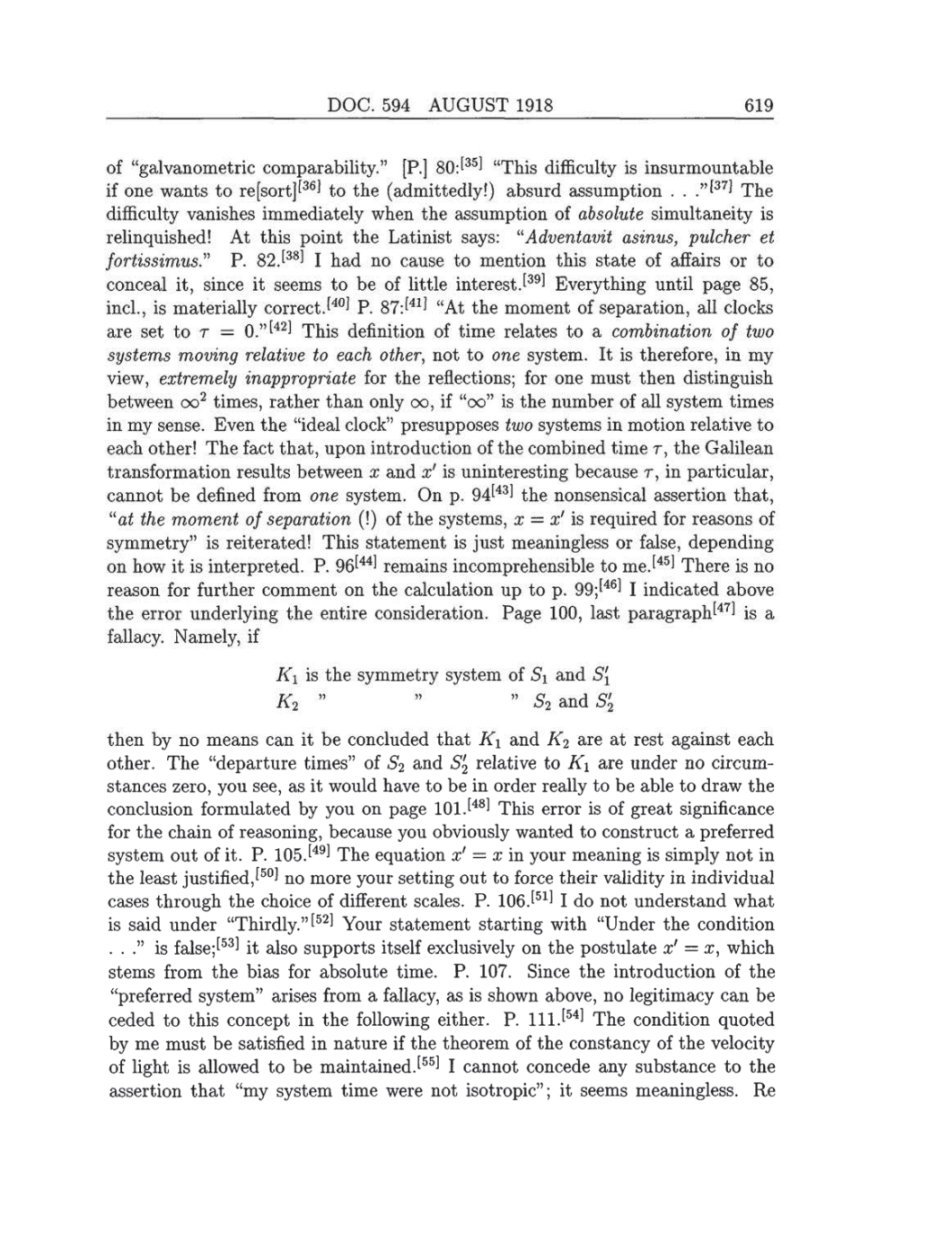DOC.
594
AUGUST
1918 619
of
“galvanometric comparability.”
[P.]
80:[35]
“This
difficulty
is
insurmountable
if
one
wants to
re[sort][36]
to
the
(admittedly!)
absurd
assumption
...”[37]
The
difficulty
vanishes
immediately
when
the
assumption
of absolute
simultaneity
is
relinquished!
At
this
point
the Latinist
says:
“Adventavit
asinus,
pulcher
et
fortissimus.”
P.
82.[38]
I
had
no cause
to mention this state of affairs
or
to
conceal
it,
since it
seems
to be
of
little
interest.[39]
Everything
until
page
85,
inch.,
is materially correct.[40]
P.
87:[41]
“At
the
moment
of
separation,
all
clocks
are
set to
r
=
0.”[42]
This definition
of
time relates to
a
combination
of
two
systems moving
relative
to each
other,
not
to
one
system.
It
is
therefore,
in
my
view, extremely
inappropriate
for
the
reflections;
for
one
must
then
distinguish
between
oo2 times,
rather
than
only
oo,
if “oo”
is
the number
of
all
system
times
in
my
sense.
Even
the
“ideal
clock”
presupposes
two
systems
in motion relative
to
each other! The fact that,
upon
introduction
of the combined time
r,
the
Galilean
transformation
results between
x
and x'
is
uninteresting
because
r,
in
particular,
cannot be defined from
one
system.
On
p.
94[43]
the
nonsensical assertion that,
“at the moment
of separation
(!)
of
the
systems,
x
=
x'
is
required
for
reasons
of
symmetry”
is
reiterated! This statement
is just
meaningless
or false,
depending
on
how
it
is interpreted. P.
96[44]
remains
incomprehensible
to
me.[45]
There
is
no
reason
for
further
comment
on
the calculation
up
to
p.
99;[46]
I
indicated
above
the
error
underlying
the entire
consideration.
Page 100,
last
paragraph[47]
is
a
fallacy. Namely,
if
K1
is
the
symmetry system
of
S1
and
S'1
K2
” ” ”
S2
and
S'2
then
by
no means
can
it be concluded
that
K1
and
K2
are
at rest
against
each
other. The
“departure
times” of
S2
and
S'2
relative to
K1 are
under
no
circum-
stances
zero, you
see, as
it would have
to
be
in
order
really
to be able
to
draw
the
conclusion formulated
by you
on page
101.[48]
This
error
is of
great significance
for
the
chain of
reasoning,
because
you obviously
wanted
to construct
a
preferred
system
out of
it.
P.
105.[49]
The
equation
x'
=
x
in
your
meaning
is
simply
not
in
the
least
justified,[50] no more
your
setting
out to
force
their
validity
in individual
cases
through
the
choice of different scales.
P.
106.[51]
I
do
not
understand what
is
said
under
“Thirdly.”[52]
Your statement
starting
with “Under
the
condition
...”
is
false;[53]
it also
supports
itself
exclusively
on
the
postulate
x'
=
x,
which
stems from
the
bias for absolute time.
P. 107. Since
the introduction
of
the
“preferred system”
arises from
a fallacy, as
is
shown
above,
no
legitimacy can
be
ceded to
this
concept
in
the
following
either.
P.
111.[54]
The condition
quoted
by
me
must be satisfied in nature
if
the theorem
of
the
constancy
of
the
velocity
of
light
is
allowed to
be
maintained.[55] I
cannot concede
any
substance to
the
assertion
that
“my
system
time
were
not
isotropic”;
it
seems
meaningless.
Re
